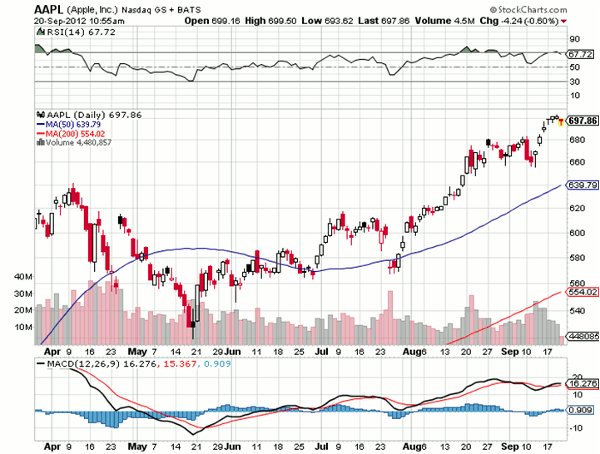Dan Passarelli shares a handy risk-limited option strategy for trading the technology giant.
Let’s say that you have a moderately bullish bias toward a stock and the overall market is slightly bullish. Is there a way that you can take advantage of this investing scenario while limiting risk?
Certainly, there are a few. One that is often superior to the rest is the bull call spread.
Definition
When executing a bull call, you purchase call options at one strike and sell the same number of calls on the same company at a higher strike with the same expiration date.
Let’s use Apple (AAPL), which is currently trading around $700 as an example. First, here is a recent daily chart:
In this case, you would purchase October calls at the 700 at-the-money strike at the ask price of $20. You would then sell the same number of October calls with a higher strike price—in this case 720—at the bid of $11.
The Math
Your maximum profit in the bull call spread is limited: you can make as much as the difference between the strike prices less the net debit paid.
For simplicity, let’s assume that you purchased one October 700 call and sold one October 720 call, resulting in a net debit of $9 (that’s $20 minus $11). The difference in the strike prices is $20 (720 minus 700). You, therefore, subtract nine from 20 to end up with a maximum profit of $11 per contract. So if you traded ten contracts, you could make $11,000.
Although you limited your upside, you also limited the downside to the net debit of $9 per contract. To simply break even, the stock would have to trade at $709 (the strike price of the purchased call (700) plus net debit ($9)).
Advantage versus Purchasing a Call
When trading the long call, your downside is limited to the net premium paid. If you simply purchased the at-the-money October 700 call you would have paid $20. The potential loss is, therefore, greater when employing a call-buying strategy.
If you move to a call with a longer time frame to expiration, you would pay even more for the option. This would also increase your potential loss per option.
Conclusion
By implementing a bull call spread, you have hedged your bets—limiting the potential loss. This is the advantage when comparing to purchasing a call outright.
Remember that there are no foolproof ways to make money by using options. However, knowing your strategy is a good way to limit losses.
Dan Passarelli can be found at MarketTaker.com.



















